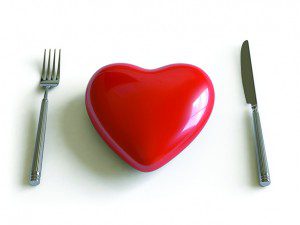

Fat in Your Food
The two main types of fat found in food are saturated and unsaturated. Most foods have a mix of both. Together, the two are called total fat.
Why should you be concerned about saturated fat?
Saturated fat raises blood cholesterol more than anything else. Over time, this extra cholesterol can clog your arteries, putting you at risk for having a heart attack or stroke.
Where is saturated fat found?
Saturated fat is found mostly in foods that come from animals. These include:
• fatty cuts of meat – beef, lamb, pork
• poultry with skin
• whole and 2% milk
• butter
• cheese
• lard
A high content of saturated fat can be found in some foods that come from plants, such as:
• palm kernel oil
• palm oil
• coconut oil
• cocoa butter
Why should you be concerned
about cholesterol?
Your body makes all the cholesterol you need. Eating foods high in saturated fat can raise your blood cholesterol levels. The higher your blood cholesterol, the greater your risk for heart disease. Too much cholesterol can lead to clogged arteries. You are then at risk for having a heart attack, a stroke, or poor circulation.
Where is cholesterol found?
Cholesterol is found in foods that come from animals. Food very high in cholesterol include:
• egg yolks
• organ meats – liver, kidney and brains are
especially high in cholesterol
There is no cholesterol in plant foods like fruits, vegetables, beans, and grains.
Limit your cholesterol.
If you are healthy, you should average no more than 300 milligrams of cholesterol per day. People who have high blood cholesterol or a heart problem may have to eat less. The yolk of one large egg provides about 214 milligrams of cholesterol. Aim for no more than four egg yolks each week. This includes egg yolks in baked goods and processed foods. Egg whites contain no cholesterol.
Cut back on saturated fat and cholesterol.
Try some of these healthier ways of cooking and shopping. Healthier ways to adapt favorite recipes:
• For biscuits – Use vegetable oil instead of lard or butter and skim milk or 1% buttermilk instead of regular milk.
• For macaroni and cheese – Use low-fat cheese and 1% or skim milk.
• For gravies or sauces – Skim the fat off pan drippings. For cream or white sauces, use skim milk and soft tub or liquid margarine.
• For dressings or stuffing – Add broth or skim-
med fat drippings instead of lard or butter. Use herbs and spices for added flavor.
• For sweet potato pie – Mash sweet potato with orange juice concentrate, nutmeg, vanilla, cinnamon, and only one egg. Leave out the butter.
• For cakes, cookies, quick breads, and pancakes – Use egg whites or egg substitute instead of whole eggs. Two egg whites can be substituted in many recipes for one whole egg. Use applesauce instead of some of the fat.
Healthy ways of cooking:
• Bake, steam, roast, broil, stew, or broil instead of frying. This helps remove fat. Try these quick tips:
o For crispy fish – Roll in cornmeal and bake.
o For crispy chicken – Remove the skin, dip in skim milk mixed with herbs and spices, roll in breadcrumbs, cornflakes, or potato flakes and bake.
• Take off poultry skin before eating.
• Use a nonstick pan with vegetable cooking oil spray or a small amount of liquid vegetable oil instead of lard, butter, shortening, or other fats that are solid at room temperature.
• Trim visible fat before you cook meats.
• Chill meat and poultry broth until fat becomes solid. Skim off fat before using the broth. Use skimmed broth to cook greens instead of fatback, hog jowls, or salt pork.
Healthy shopping tips:
• Choose chicken breast or drumstick instead of the wing and thigh.
• Select skim milk or 1% instead of 2% or whole milk (sweet).
• Buy lean cuts of meat such as round, sirloin, and loin.
• Buy more vegetables, fruits, and grains.
• Read nutrition labels on food packages and limit foods with saturated fat.
Let the food label help you choose foods lower in saturated fat and cholesterol.
When you select a food, reading the food label can help you view its saturated fat and cholesterol levels. At first, reading labels may be confusing, but the more you do it, the easier it will become. Soon you will be able to easily make food choices that are heart healthy.
• Size up your food. Compare the amount you eat to the serving size. If you eat 2 cups and the serving size is 1 cup, you have to double the amounts listed.
• Use the “%Daily Value” to compare the amounts of total fat, saturated fat, and cholesterol among brands. Choose those that have lower values. If one serving of a food contains 20% of the Daily Value for total fat and you eat two servings, then you have consumed 40% of total fats you should eat for the entire day.
Being mindful of what you are eating can help prevent high cholesterol and artery blockage, thus decreasing your risk of developing a heart problem. If you have any questions or need further information on which food to avoid and which foods to consumer more of, the cardiac specialists and their team at Cardiac Care Group are happy to speak with you and address your concerns.
Cardiac Care Group
(239) 574-8463
www.flccg.com
 Southwest Florida's Health and Wellness Magazine Health and Wellness Articles
Southwest Florida's Health and Wellness Magazine Health and Wellness Articles

